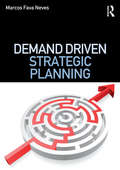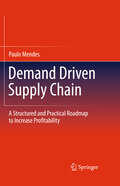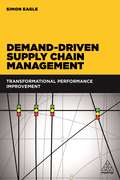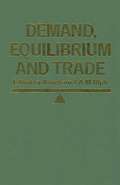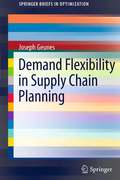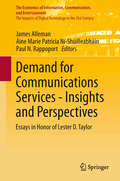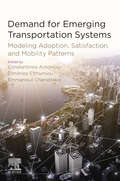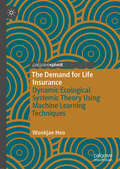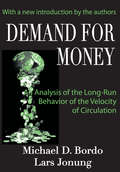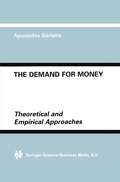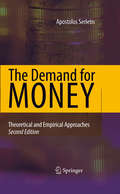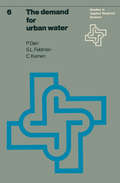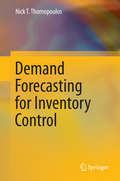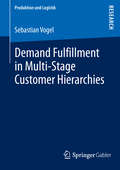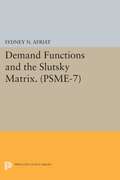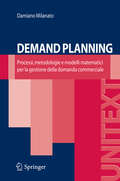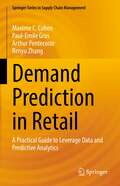- Table View
- List View
Demand Driven Strategic Planning
by Marcos Fava NevesThis book offers students and practitioners alike an integrated approach to strategic planning for companies. Marcos Fava Neves presents a new and unique perspective on this critical topic based on three main points: strongly demand-driven decisions that bridge the gap between long- and short-term strategy; a vision of a company as an integrated network, full of relationships that deserve consideration during the planning process; and the introduction of ‘collective-action’ thinking, which raises the prospect for cooperation between competitors. With this clear, comprehensive framework for strategic planning, companies can be sure to navigate today’s complex environment and enhance their prospects of success.
Demand Driven Strategic Planning
by Marcos Fava NevesThis book offers students and practitioners alike an integrated approach to strategic planning for companies. Marcos Fava Neves presents a new and unique perspective on this critical topic based on three main points: strongly demand-driven decisions that bridge the gap between long- and short-term strategy; a vision of a company as an integrated network, full of relationships that deserve consideration during the planning process; and the introduction of ‘collective-action’ thinking, which raises the prospect for cooperation between competitors. With this clear, comprehensive framework for strategic planning, companies can be sure to navigate today’s complex environment and enhance their prospects of success.
Demand Driven Supply Chain: A Structured and Practical Roadmap to Increase Profitability
by Paulo MendesThis book aims to identify and describe the practical key components of demand driven supply chains, and based on these components, develops a structured and integrated assessment framework that companies can use to assess their current and desired future supply chain states in light of the Demand Driven Supply Chain (DDSC) concepts. Another contribution of the book is the structured framework developed to design a supply chain strategy, which will consider the DDSC assessment results as one of the key inputs, and will support the implementation of the opportunities identified during the assessment.The framework presented in this book was applied in different supply chain operations of a global CPG company to validate the methodology and formalize an action plan to allow these operations move towards a DDSC. Results show clear opportunities to improve supply chain operation and become more demand driven.
Demand-Driven Supply Chain Management: Transformational Performance Improvement
by Simon EagleMany manufacturing and distribution companies are moving from the traditional 'forecast push MRP' to demand-driven supply chain management (SCM). Demand-driven SCM is an 'end-to-end' supply chain planning and replenishment process that enables companies to achieve their planned service levels from up to half the average level of inventory and requiring significantly less throughput capacity - irrespective of the level of demand volatility or lead-time length. Demand-Driven Supply Chain Management is the go-to source for industry supply chain/operations executives and students. It describes the 'what, how and why' of the demand-driven SCM process. The key themes in the book are: what is demand-driven? why is demand-driven so effective? how to operate a demand-driven supply chain? and how to adopt the demand-driven process in your company? Readers can quickly grasp the essential concepts from one of numerous self-contained sections that present the book's key concepts from different perspectives. Online resources available include full-colour figures.
Demand-Driven Supply Chain Management: Transformational Performance Improvement
by Simon EagleMany manufacturing and distribution companies are moving from the traditional 'forecast push MRP' to demand-driven supply chain management (SCM). Demand-driven SCM is an 'end-to-end' supply chain planning and replenishment process that enables companies to achieve their planned service levels from up to half the average level of inventory and requiring significantly less throughput capacity - irrespective of the level of demand volatility or lead-time length. Demand-Driven Supply Chain Management is the go-to source for industry supply chain/operations executives and students. It describes the 'what, how and why' of the demand-driven SCM process. The key themes in the book are: what is demand-driven? why is demand-driven so effective? how to operate a demand-driven supply chain? and how to adopt the demand-driven process in your company? Readers can quickly grasp the essential concepts from one of numerous self-contained sections that present the book's key concepts from different perspectives. Online resources available include full-colour figures.
Demand Flexibility in Supply Chain Planning (SpringerBriefs in Optimization)
by Joseph GeunesThis work encapsulates the essential developments in this field into a single resource, as well as to set an agenda for further development in the field. This brief focuses on the demand flexibility in supply chains with fragmented results distributed throughout the literature. These results have strong implications for managing real-world complex operations planning problems.This book exploits dimensions of demand flexibility in supply chains and characterizes the best fit between demand properties and operations capabilities and constraints. The origins and seminal works are traced in integrated demand and operations planning and an in-depth documentation is provided for the current state of the art. Systems with inherent costs and constraints that must respond to some set of demands at a minimum cost are examined. Crucial unanswered questions are explored and the high-value research directions are highlighted for both practice and for the development of new and interesting optimization models and algorithms.
Demand for Communications Services – Insights and Perspectives: Essays in Honor of Lester D. Taylor (The Economics of Information, Communication, and Entertainment)
by James Alleman Áine Marie Patricia Ní-Shúilleabháin Paul N. RappoportThis volume grew out of a conference organized by James Alleman and Paul Rappoport, conducted on October 10, 2011 in Jackson Hole, Wyoming, in honor of the work of Lester D. Taylor, whose pioneering work in demand and market analysis has had profound implications on research across a wide spectrum of industries. In his Prologue, Eli M. Noam notes that demand analysis in the information sector must recognize the “public good” characteristics of media products and networks, while taking into account the effects of interdependent user behavior; the strong cross-elasticities in a market; as well as the phenomenon of supply creating its own demand. The second Prologue, by Timothy Tardiff and Daniel Levy, focuses more specifically on Taylor’s body of work, in particular its practical applications and usefulness in analyses of, and practices within, the Information and Communications Technology (ICT) sector (known in Europe and elsewhere as the Telecommunications, Media, and Technology (TMT) sector). The remainder of the book is organized into four parts: Advances in Theory; Empirical Applications; Evidence-Based Policy Applications; and a final Conclusion. The book closes with an Appendix by Sharon Levin and Stanford Levin detailing Taylor’s contributions using bibliometrics. Not only featuring chapters from distinguished scholars in economics, applied sciences, and technology, this volume includes two contributions directly from Lester Taylor, providing unique insight into economics from a lifetime in the field. “What a worthy book! Every applied researcher in communications encounters Lester Taylor’s work. Many empirical exercises in communications can trace their roots to Taylor’s pioneering research and his thoughtful leadership. This book assembles an impressive set of contributors and contributions to honor Taylor. No surprise, the collection extends far and wide into many of the core topics of communications and media markets. The emphasis is where it should be–on important and novel research questions informed by useful data. —Shane Greenstein, Professor of Management and Strategy, Kellogg School of Management, Northwestern University “For more than 40 years, Lester Taylor has been a leader in the application of consumer modeling, econometric techniques and microeconomic data to understand residential and business user behavior in telecommunications markets. During that time, he inspired a cadre of students and colleagues who applied this potent combination to address critical corporate andregulatory issues arising in the telecommunications sector. This volume collects the recent product of many of these same researchers and several other devotees who go beyond empirical analysis of fixed line service by extending Prof. Taylor’s approach to the next wave of services and technologies. These contributions, including two new papers by Prof. Taylor, offer an opportunity for the next generation to learn from his work as it grapples with the pressing issues of consumer demand in the rapidly evolving digital economy.” — Glenn Woroch, Adjunct Professor of Economics, University of California, Berkeley
Demand for Emerging Transportation Systems: Modeling Adoption, Satisfaction, and Mobility Patterns
by Constantinos Antoniou Dimitrios Efthymiou Emmanouil ChaniotakisDemand for Emerging Transportation Systems: Modeling Adoption, Satisfaction, and Mobility Patterns comprehensively examines the concepts and factors affecting user quality-of-service satisfaction. The book provides an introduction to the latest trends in transportation, followed by a critical review of factors affecting traditional and emerging transportation system adoption rates and user retention. This collection includes a rigorous introduction to the tools necessary for analyzing these factors, as well as Big Data collection methodologies, such as smartphone and social media analysis. Researchers will be guided through the nuances of transport and mobility services adoption, closing with an outlook of, and recommendations for, future research on the topic. This resource will appeal to practitioners and graduate students.Examines the dynamics affecting adoption rates for public transportation, vehicle-sharing, ridesharing systems and autonomous vehiclesCovers the rationale behind travelers’ continuous use of mobility services and their satisfaction and developmentIncludes case studies, featuring mobility stats and contributions from around the world
The Demand for Imports and Exports in the World Economy (Routledge Revivals)
by W. Charles Sawyer Richard L. SprinkleFirst published in 1999, this volume responds to one of the more important issues in applied international economics: the extent to which trade flows adjust to changes in income, relative prices and exchange rates. This work surveys the literature on empirical estimation of the demand for imports and exports for the US. The book is designed to be a reference book for both academic international economists and international trade practitioners in government, international organisations and the private sector.
The Demand for Imports and Exports in the World Economy (Routledge Revivals)
by W. Charles Sawyer Richard L. SprinkleFirst published in 1999, this volume responds to one of the more important issues in applied international economics: the extent to which trade flows adjust to changes in income, relative prices and exchange rates. This work surveys the literature on empirical estimation of the demand for imports and exports for the US. The book is designed to be a reference book for both academic international economists and international trade practitioners in government, international organisations and the private sector.
The Demand for International Football Telecasts in the United States (Palgrave Pivots in Sports Economics)
by Georgios Nalbantis Tim PawlowskiThis book provides a comprehensive overview and economic analysis of US consumer demand for televised football (soccer). Accounting for transnational demand, research is focused on the US consumers demand for the English Premier League, Spanish La Liga, Italian Serie A, German Bundesliga, French Ligue 1 and the UEFA Champions League, which represent the most popular and marketable football competitions worldwide, and have recently sealed lucrative media rights contracts in many large markets, including the US. The study also takes account of North American Major League Soccer (MLS) in order to provide a more comprehensive overview of the country's football market and to allow for direct comparisons with the aforementioned European competitions.These findings offer valuable insights for US broadcasters, European league organizers and managers to adjust existing strategies and/or develop new strategies in conquering the US football market.
Demand for Labor: The Neglected Side of the Market (IZA Prize in Labor Economics)
by Daniel S. HamermeshThe book collects articles published by Daniel Hamermesh between 1969 and 2013 dealing with the general topic of the demand for labor. The first section presents empirical studies of basic issues in labor demand, including the extent to which different types of labor are substitutes, how firms' and workers' investments affect labor turnover, and how costs of adjusting employment affect the dynamics of employment and patterns of labor turnover. The second section examines the impacts of various labor-market policies, including minimum wages, penalty pay for using overtime hours or hours worked on weekends or nights, severance pay for displaced workers, and payroll taxes to finance unemployment insurance benefits. The final section deals with general questions of discrimination by employers along various dimensions, including looks, gender and ethnicity, in all cases focusing on the process of discrimination and the behavior that results. Throughout the focus is on the development of theoretically-based hypotheses and testing them using the most appropriate data, often data collected uniquely for the particular project.
The Demand for Life Insurance: Dynamic Ecological Systemic Theory Using Machine Learning Techniques
by Wookjae HeoThis book, adopting machine learning techniques for the financial planning field, explores the demand for life insurance as seen in previous literature and both estimates and predicts the demand for the adoption of life insurance using these techniques. Previous studies used diverse perspectives, like actuarial and life span, in order to understand the demand for life insurance, though these approaches have shown inconsistent findings. Employing two theoretical backgrounds—ecological systemic theory and artificial intellectual methodology—this book explores a better estimation and a prediction of the demand for life insurance and will be of interest to academics and students of insurance, financial planning, and risk management.
Demand for Money: An Analysis of the Long-run Behavior of the Velocity of Circulation
by Lars JonungThe income velocity of money-an inverse measure of the demand for money balances-is the ratio of the money value of income to the average money stock that the public (excluding banks) holds in a given period. Why the magnitude of that ratio has changed over time is the subject of Michael D. Bordo and Lars Jonung's classic study, originally published as The Long-Run Behavior of the Velocity of Circulation. Supported by statistical data, econometric estimation techniques, and meticulous historical analysis, this work describes, in an international setting, how slow-moving economic, social, and political forces interact with the decisions households and firms make about how much money to hold.Annual time series of velocity for several countries from the late nineteenth century to the late twentieth century display a U-shaped pattern. Existing theories can explain each section of the velocity curve-the falling, flat, and rising parts-but the overall pattern is not consistent with any one theory. Here the authors put forth a comprehensive explanation for this behavior over time. Their theory is largely an extension of the approach of Knut Wicksell, the Swedish economist who stressed the role of substitution between monetary assets. This approach, which emphasizes institutional variables, is incorporated into the arguments for the traditional long-run money demand (velocity) function. Four types of empirical evidence strongly support the authors' theory: econometric studies of the long-run velocity function for several countries; a cross section study of approximately eighty countries in the postwar period; a case study of the Swedish monetization process in the fifty years before World War I; and an examination of the time series properties of velocity.Demand for Money suggests that institutional factors, as opposed to real income, play a greater role in velocity than previously thought. And these institutional factors have a major impact on monetary policy. This is a book that will prove of great value to economists, monetary strategists, and policymakers.
Demand for Money: An Analysis of the Long-run Behavior of the Velocity of Circulation
by Lars JonungThe income velocity of money-an inverse measure of the demand for money balances-is the ratio of the money value of income to the average money stock that the public (excluding banks) holds in a given period. Why the magnitude of that ratio has changed over time is the subject of Michael D. Bordo and Lars Jonung's classic study, originally published as The Long-Run Behavior of the Velocity of Circulation. Supported by statistical data, econometric estimation techniques, and meticulous historical analysis, this work describes, in an international setting, how slow-moving economic, social, and political forces interact with the decisions households and firms make about how much money to hold.Annual time series of velocity for several countries from the late nineteenth century to the late twentieth century display a U-shaped pattern. Existing theories can explain each section of the velocity curve-the falling, flat, and rising parts-but the overall pattern is not consistent with any one theory. Here the authors put forth a comprehensive explanation for this behavior over time. Their theory is largely an extension of the approach of Knut Wicksell, the Swedish economist who stressed the role of substitution between monetary assets. This approach, which emphasizes institutional variables, is incorporated into the arguments for the traditional long-run money demand (velocity) function. Four types of empirical evidence strongly support the authors' theory: econometric studies of the long-run velocity function for several countries; a cross section study of approximately eighty countries in the postwar period; a case study of the Swedish monetization process in the fifty years before World War I; and an examination of the time series properties of velocity.Demand for Money suggests that institutional factors, as opposed to real income, play a greater role in velocity than previously thought. And these institutional factors have a major impact on monetary policy. This is a book that will prove of great value to economists, monetary strategists, and policymakers.
The Demand for Money: Theoretical and Empirical Approaches
by Apostolos SerletisAlmost half a century has elapsed since the demand for money began to attract widespread attention from economists and econometricians, and it has been a topic of ongoing controversy and research ever since. Interest in the topic stemmed from three principal sources. First of all, there was the matter of the internal dynamics of macroeco nomics, to which Harry Johnson drew attention in his 1971 Ely Lecture on "The Keynesian Revolution and the Monetarist Counter-Revolution," American Economic Review 61 (May 1971). The main lesson about money that had been drawn from the so-called "Keynesian Revolution" was - rightly or wrongly - that it didn't matter all that much. The inherited wisdom that undergraduates absorbed in the 1950s was that macroeconomics was above all about the determination of income and employment, that the critical factors here were saving and investment decisions, and that monetary factors, to the extent that they mattered at all, only had an influence on these all important variables through a rather narrow range of market interest rates. Conventional wisdom never goes unchallenged in economics, except where its creators manage to control access to graduate schools and the journals, and it is with no cynical intent that I confirm Johnson's suggestion that those of us who embarked on academic careers in the '60s found in this wisdom a ready-made target.
The Demand for Money: Theoretical and Empirical Approaches
by Apostolos SerletisThis is the most comprehensive textbook available on the money demand function and its role in modern macroeconomics. The book takes a microeconomic- and aggregation-theoretic approach to the topic and presents empirical evidence using state-of-the-art econometric methodology, while recognizing the existence of unsolved problems and the need for further developments. The new edition is fully revised and includes new chapters.
The demand for urban water (Studies in Applied Regional Science #6)
by P. Darr S.L. Feldman C.S. KamenThis book is written for students and scholars seeking a rather 'unconven tional' approach to the problem of water supply planning. The 'uncon ventionality' is present in the adoption of social psychological tools for the economic planning of water system design in an arid environment. The theoretics of Chapter I provides the framework for the empirical analysis of the ensuing chapters. The language of that chapter is designed to be under standable to students in introductory regional science, economics or geography courses, as well as professionals in allied fields. The fresh approach of the empirical analysis should lift the field of urban water resources analysis into using a greater expanse of tools and methods for policy planning. In any case, it is signifying that straightforward engineer ing analysis in most cases may be made more effective by socio-economic studies as that carried out in Israel. Indeed the guidelines and specifications presented in this work are presently being used by Israeli planners. A number of individuals and institutions contributed greatly to this effort. Foremost, the authors would like to thank Tahal Consulting Engineers, Inc. , for funding the major part of this study. Ms. Suzy Ashkenazi of that organization aided in data analysis. The authors especially express their indebtedness to Dr. Shalom Reichman of the Hebrew University. His reading of a number of drafts and permitting further funding through the Hebrew University Social Science Research Council was more than invalu able.
Demand Forecasting for Inventory Control
by Nick T. ThomopoulosThis book describes the methods used to forecast the demands at inventory holding locations. The methods are proven, practical and doable for most applications, and pertain to demand patterns that are horizontal, trending, seasonal, promotion and multi-sku. The forecasting methods include regression, moving averages, discounting, smoothing, two-stage forecasts, dampening forecasts, advance demand forecasts, initial forecasts, all time forecasts, top-down, bottom-up, raw and integer forecasts, Also described are demand history, demand profile, forecast error, coefficient of variation, forecast sensitivity and filtering outliers. The book shows how the forecasts with the standard normal, partial normal and truncated normal distributions are used to generate the safety stock for the availability and the percent fill customer service methods. The material presents topics that people want and should know in the work place. The presentation is easy to read for students and practitioners; there is little need to delve into difficult mathematical relationships, and numerical examples are presented throughout to guide the reader on applications. Practitioners will be able to apply the methods learned to the systems in their locations, and the typical worker will want the book on their bookshelf for reference. The potential market is vast. It includes everyone in professional organizations like APICS, DSI and INFORMS; MBA graduates, people in industry, and students in management science, business and industrial engineering.
Demand Fulfillment bei Assemble-to-Order-Fertigung: Analyse, Optimierung und Anwendung in der Computerindustrie (Produktion und Logistik)
by Sebastian GeierDas Demand Fulfillment hat im Zuge der Online-Auftragsübermittlung für viele Unternehmen an Bedeutung gewonnen. Es stellt eine Möglichkeit zur Erhöhung der Lieferfähigkeit und Liefertreue dar. Sebastian Geier entwickelt für eine Assemble-to-Order-Fertigung ein neuartiges Konzept für die rollierende Planung des Demand Fulfillment. Dieses Konzept wird anhand einer umfangreichen Fallstudie mit realen Daten eines Elektronik-Herstellers getestet. Die Tests zeigen interessante Auswirkungen verschiedener Engpass-Maßnahmen auf die unterschiedlichen Ziele des Demand Fulfillment.
Demand Fulfillment in Multi-Stage Customer Hierarchies (Produktion und Logistik)
by Sebastian VogelThis book extends the existing demand fulfillment research by considering multi-stage customer hierarchies. Basis is a two-step allocation and consumption planning procedure. In the existing literature, it is assumed that the customer segments are ‘flat’. This means they can be sorted easily during the allocation planning step by a single central planner in decreasing order of profitability. In the subsequent consumption planning phase, if order requests differ in terms of profit margins, companies can render prioritized service in real time to their most profitable customers by consuming the reserved quotas.
Demand Functions and the Slutsky Matrix. (PSME-7), Volume 7 (PDF)
by Sydney N. AfriatThe utility idea has had a long history in economics, especially in the explanation of demand and in welfare economics. In a comprehensive survey and critique of the Slutsky theory and the pattern to which it belongs in the economic context, S. N. Afriat offers a resolution of questions central to its main idea, including sufficient conditions as well.Originally published in 1980.The Princeton Legacy Library uses the latest print-on-demand technology to again make available previously out-of-print books from the distinguished backlist of Princeton University Press. These editions preserve the original texts of these important books while presenting them in durable paperback and hardcover editions. The goal of the Princeton Legacy Library is to vastly increase access to the rich scholarly heritage found in the thousands of books published by Princeton University Press since its founding in 1905.
Demand Planning: Processi, metodologie e modelli matematici per la gestione della domanda commerciale (UNITEXT)
by Damiano MilanatoIl libro analizza metodi quantitativi, modelli matematici e processi aziendali per la gestione e la pianificazione della domanda commerciale delle aziende, relativa ai prodotti ed ai servizi realizzati. Fattori competitivi quali la proliferazione della gamma di prodotti, l’introduzione continua di nuovi prodotti presso nuovi mercati o canali distributivi, il limitato ciclo di vita dei prodotti, la progettazione di attività promozionali rivolte a fidelizzare i clienti e ad accrescere la quota di mercato aziendale, indicano il processo di Demand Planning come cruciale e strategico per la competitività delle aziende. Il testo affronta la complessità inerente la progettazione, la gestione e la manutenzione di un sistema di Demand Planning, attraverso le fasi di conduzione dei processi ad esso afferenti.
Demand Prediction in Retail: A Practical Guide to Leverage Data and Predictive Analytics (Springer Series in Supply Chain Management #14)
by Maxime C. Cohen Paul-Emile Gras Arthur Pentecoste Renyu ZhangFrom data collection to evaluation and visualization of prediction results, this book provides a comprehensive overview of the process of predicting demand for retailers. Each step is illustrated with the relevant code and implementation details to demystify how historical data can be leveraged to predict future demand. The tools and methods presented can be applied to most retail settings, both online and brick-and-mortar, such as fashion, electronics, groceries, and furniture. This book is intended to help students in business analytics and data scientists better master how to leverage data for predicting demand in retail applications. It can also be used as a guide for supply chain practitioners who are interested in predicting demand. It enables readers to understand how to leverage data to predict future demand, how to clean and pre-process the data to make it suitable for predictive analytics, what the common caveats are in terms of implementation and how to assess prediction accuracy.
